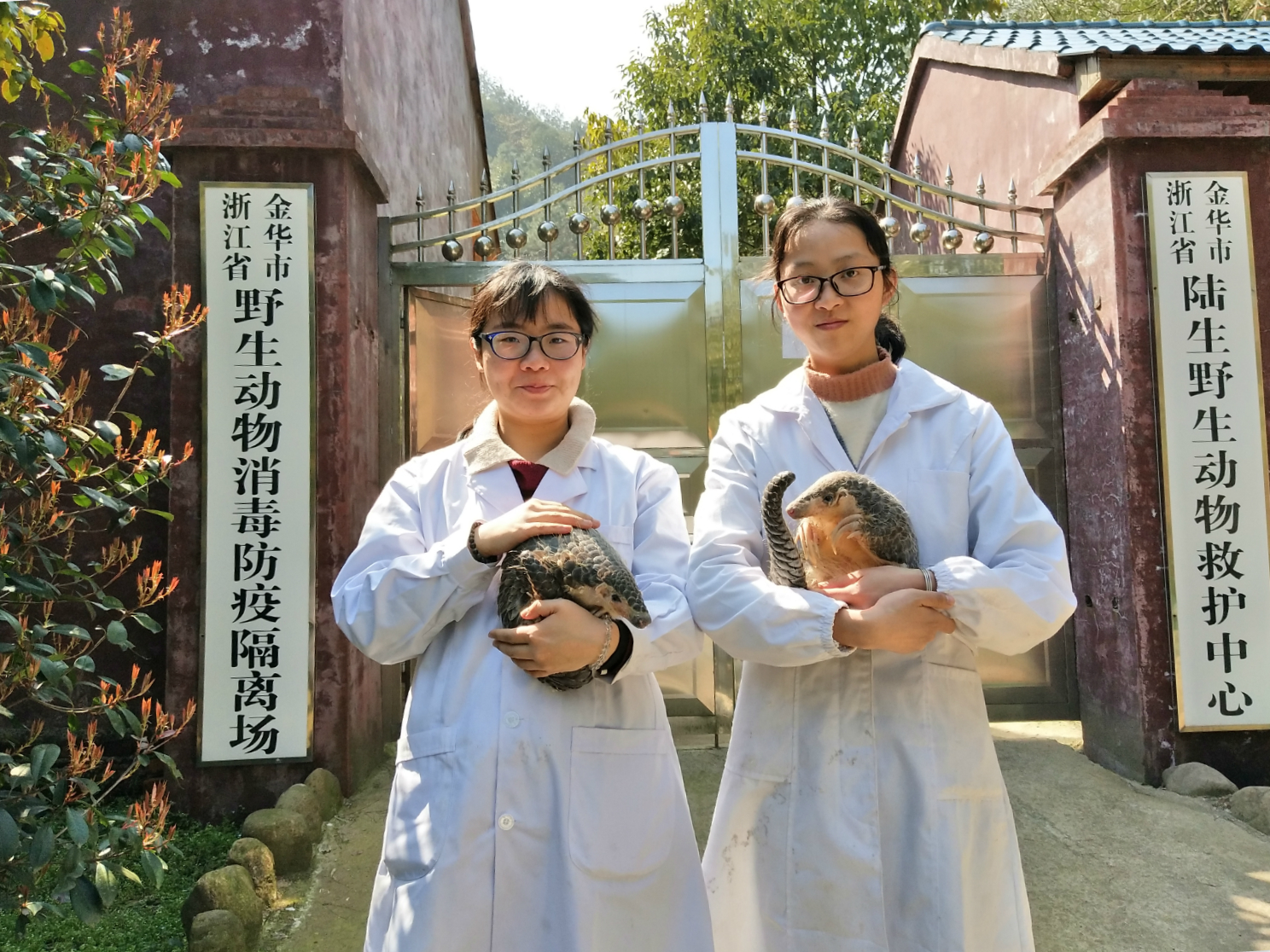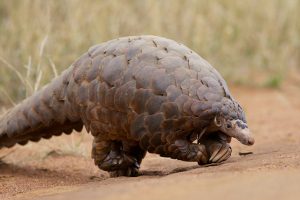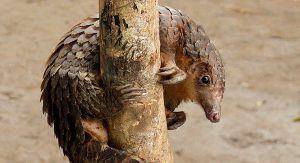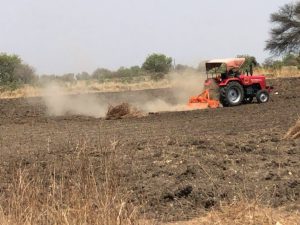Ranger Lu Hanrong pointed to an evergreen tree. “I was on patrol, when something round fell off the slope onto the dirt road in front of me. Before I recognised it as a pangolin, it started to move slowly to the other side of the road and climbed up that tree looking for termites.” Lu was speaking to a captivated group of visitors to a remote forest reserve – Shiwan Dashan (a Hundred Thousand Mountains) – in Guangxi Zhuang Autonomous Region near the Chinese border with Vietnam.
He held up his phone, which had a blurry photo of the reclusive and highly endangered mammal, which he had taken in April 2018. The visitors, local forestry bureau staff, an animal scientist and a member of a domestic NGO dedicated to pangolin preservation were excited to hear Lu’s tale, since their mission, in late February, was to find a suitable natural habitat to rewild pangolins.
“This is the first time a wild pangolin was found in Guangxi in recent years as far as I know. It’s almost never seen in the wild in China now. We tried to explore the area to find any burrows of that living pangolin, but we ran out of time,” said Zhang Siyuan from the China Biodiversity Conservation and Green Development Foundation (CBCGDF), a domestic non-profit public foundation. “We can tell this is an ideal habitat for pangolins: thick soil, proper forest coverage. And most importantly plenty of ants and termites to meet the species’ unique dietary needs but not much human activity to disturb them,” he said.
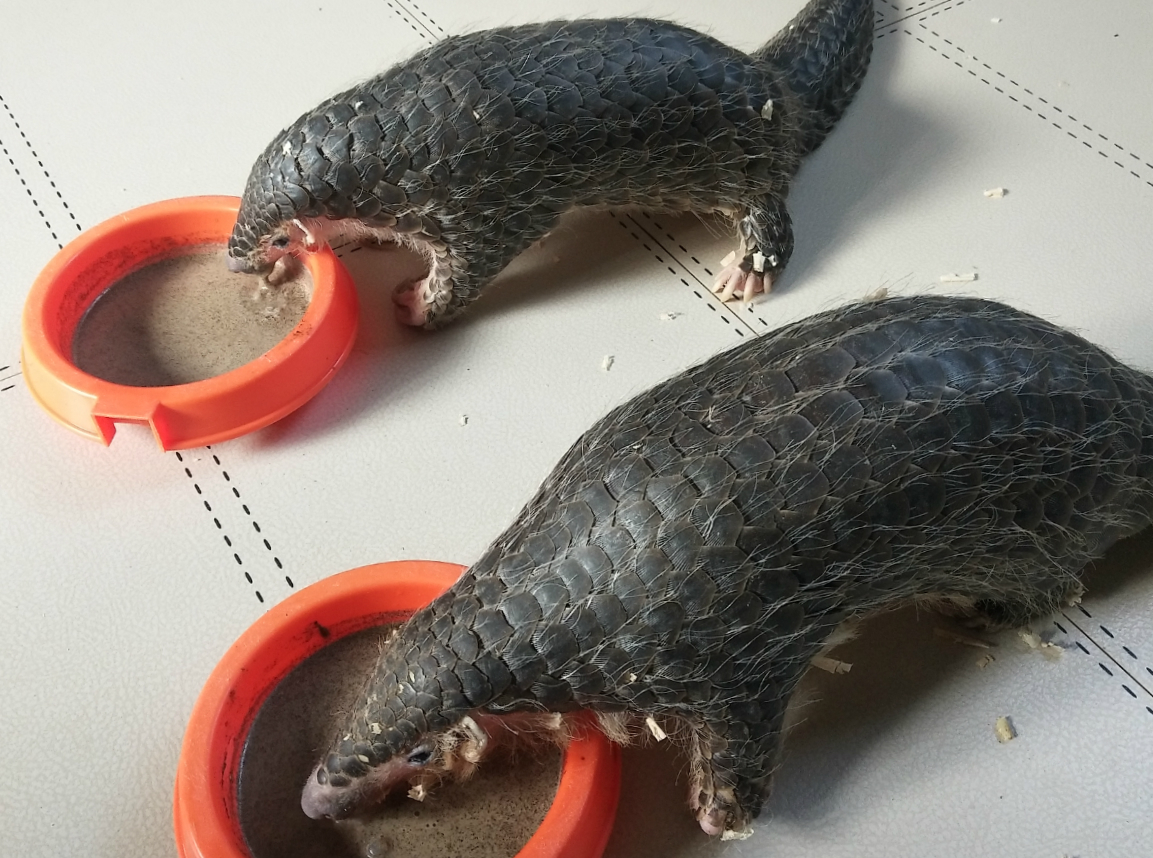
Two pangolins at the rescue centre in Zhejiang (Image: Meng Haifeng, Jinhua Wildlife Rescue Centre)
Overexploitation
All eight species of pangolins found in Asia and Africa are listed as “endangered” or worse on the International Union for Conservation of Nature (IUCN) Red List of Threatened Species. The Chinese pangolin (Manis pentadactyla), once prevalent in most parts of southern China, was classified as “critically endangered” in 2014 due to overconsumption for medicinal purposes.
In the 1960s, 170,000-180,000 pangolins were captured annually in China, according to statistics collected by CBCGDF. By the late 1990s, the annual catch was only a few hundred kilograms. Official statistics indicate the average annual consumption of pangolin scales was around 26.6 tonnes between 2008 through to 2015.
In reality the species, often described by wildlife NGOs as the most trafficked animal in the world, is on the verge of disappearing in the wild in China. According to the IUCN, in the decade up to 2014, more than one million pangolins across the globe were poached and illegally traded to satisfy demand from consumers in Asia, particularly China. The crisis led to pangolin species being moved in 2016 from Appendix II to Appendix I of CITES (Convention on International Trade in Endangered Species of Wild Fauna and Flora), which indicates the species is threatened with extinction and is prohibited from any form of international commercial trade. China has ratified this treaty.
Medicinal use poorly regulated
Pangolins are reclusive mammals with protective keratin scales covering their skin and long, sticky tongues that enable them to eat ants and termites. Throughout history, pangolin scales have been used in traditional Chinese medicine. “Roast pangolin scales are used, combined with other traditional material, to promote blood circulation, dispel clotting or swelling, and it is used more often on women who want to stimulate lactation after giving birth or on people who suffer from cancer,” said Sun Xiuqing, a senior traditional Chinese medicine doctor at Jingshun hospital in Beijing.
The sale and purchase of pangolins is prohibited under China’s Wild Animal Protection Law, except if used for scientific research, captive breeding, exhibition or other special purposes, such as in traditional Chinese medicine.
In 2007, the then State Forestry Administration (SFA, now National Forest and Grasslands Administration) established a special marking system to regulate the medicinal use. The system limits the legal use of pangolin scales to verified stockpiles from the SFA or other legal sources in licensed hospitals and authorised pharmaceutical companies. Sun admitted that with the tightening control and regulation, as well as the increasing price of pangolin scales, doctors use them less often.
“There are some alternative substitutes for pangolin scales though the medicinal effects are not comparable,” said Shi Yu, another doctor from Jingshun hospital. “But the doctors in our hospital are aware of the protected status of the animal, so we rarely prescribe them.”
Pangolin scales, like rhino horn, in fact have no proven medicinal value. “According to chemical analysis, the main component of pangolin scales is keratin, similar to human fingernails. As each capsule contains such a small amount of pangolin scales, it is difficult to see that it has any medicinal effect,” stated a CBCGDF report on the overexploitation of pangolins published in July 2016.
At a conservation event organised by WildAid in Hong Kong in September 2018, some traditional Chinese medicine experts urged the use of alternatives.
“Many herbal medicines have very similar functions to pangolin scales,” said Lao Lixing, director of Hong Kong University’s School of Chinese Medicine, the South China Morning Post reported.
Lao listed six substitutes including cowherb seeds and earthworms which can be used to treat certain conditions instead of pangolin scales.
Legal cover for black market
Zhang Mingxia, an assistant researcher from Xishuangbanna Tropical Botanical Garden, said that legal pangolin scale products should be packaged with an official logo of a deer head. “If pangolin scales are not packaged when they’re sold, then it’s illegal for sure,” Zhang said.
However, during research carried out by NewsChina on the availability of pangolin scales, both at traditional Chinese medicine pharmacies and on e-commerce websites, packs of scales without the official logo were readily available.
At a branch of Tong Ren Tang, a major producer of traditional Chinese medicine, a pack of scales with the official logo was retailing for 180 yuan (US$27). Powdered scales are more expensive, costing 420 yuan (US$63) for 21 grams. But three retailers on e-commerce site Taobao, operated by Alibaba Group, offered unpackaged pangolin scales for around five yuan (US$0.5) per gram, almost certainly illegal.

A packet of pangolin scales sells for 180 yuan (USD$27) at a Tong Ren Tang outlet in Beijing, March 1, 2019 (Image: Wang Yan)
A pharmacist called Zhu from Hangzhou, capital of Zhejiang province, disclosed to the reporter that hospitals purchase pangolin scales from authorised medicine wholesalers, but due to lack of regulation, wholesalers often mix illegally sourced pangolin parts with legal ones.
“A huge quantity of the sold pangolin scales are illegal, since wholesalers can easily mix legal scales with trafficked pangolin parts to escape supervision,” said Zhou Jinfeng, secretary-general of CBCGDF. Indeed, since 2016 the Chinese government has not published data on pangolin scale quotas. The national legal stockpile of pangolin scales also remains a mystery. The National Forest and Grasslands Administration (NFGA) did not respond to NewsChina’s inquiry on the current status of stockpiles of pangolin scales and the annual allocated consumption quotas. Instead, the NFGA only stated in a vague written response that it vows to “continue its efforts in the registration of live pangolins and scale stockpiles.”
“A well-managed stockpile system would effectively prohibit the sale of illegal pangolin scales, but now it is clear that the NFGA does not have control over the stockpile, so it cannot give us any statistics on that,” Zhou said.
Meanwhile, international trafficking of pangolins continues. In 2018 alone, according to the CBCGDF, authorities seized 38.14 tonnes of illegally traded pangolin scales from six domestic custom offices, including Shenzhen, Nanning, Shanghai, Jiangmen, Guangdong and Hong Kong, which means at least some 60,000 pangolins were killed.
An updated version of China’s Wildlife Protection Law in 2017 clearly prohibits consumption of pangolin meat and the sale of illegally sourced scales. Yet wildlife authorities are in a constant battle to crackdown on the trade in pangolins.
In late 2018, police from Central China’s Hunan Province identified a large pangolin trafficking ring involving over 200 suspects after a year-long investigation. According to the Hunan Provincial Forestry Bureau, “The pangolins were trafficked into Guangxi from overseas, and then sold to suspects in Guangzhou province, from where they were distributed to other parts of China.” Arrests were made in six southern provinces. According to China’s Wildlife Protection Law, people involved in the trade in endangered wild animals face more than 10 years in prison, plus fines.
Captive breeding
As China cracks down on the illegal trafficking, surviving pangolins are sent to rescue centres. However, despite decades of efforts, pangolins do not adapt well to life in captivity.
“Captive breeding of pangolins started as early as the 1980s in China, yet without significant success. I started my pangolin breeding research in 2010, and they only survive an average of two to three years in human care,” said a domestic pangolin expert who spoke on condition of anonymity. In the wild, a pangolin can live up to 20 years.
Many rescued pangolins often die within a few months or at most a few years due to a so-far-unidentified gastrointestinal disease or pneumonia. “So far there are no successful conservation breeding programs for pangolins, and so we need further scientific research for the purpose of pangolin species conservation,” the expert said.
Due to the high mortality rate, successful captive breeding remains elusive. At the Jinhua Wildlife Rescue Centre in Zhejiang province, former keeper Xiao Chen said she really missed two pangolins, Rou Rou (meaty) and Tuan Tuan (chubby) she had taken care of for several months. “When I first saw them in December 2017, they would eat a prepared diet by themselves,” Xiao said. “They were very timid and would stop and sniff when you came to them.” She adored the creatures, and when the weather was warm, she and the other staff would take them to forage around in the nearby clumps of bamboo.
But in April 2018, the two pangolins suddenly fell ill and died. Xiao Chen cried for two days and left the job with a broken heart. “Although we didn’t know why they died, I still felt so responsible for not being capable or professional enough, otherwise I might have saved their lives,” said Xiao.
Since 2017, forestry authorities have sent all 12 pangolins found in Zhejiang to Jinhua for rescue and breeding.
But in mid-March, when NewsChina visited the rescue centre inside Jinhua Zoo, there were only two pangolins still alive, one wounded Chinese pangolin rescued in July 2018 and a Sunda pangolin (a species from Southeast Asia) sent over in late January 2019.
Wang Pei, manager of the rescue centre, prepares a diet of dried ants, bee larvae and other protein and vitamins. “At first, I tried to feed them with their familiar diet of ants and termites so they could acclimatise to the new environment, and then I slowly added other ingredients,” Wang said.
“We are learning gradually how to take care of them. Each rescued pangolin has a unique temperament, so you need to know that well,” Wang said, admitting the survival rate of rescued wounded pangolins has been low during the two years he’s been trying to rear them.
Wang said that it was not possible for a single rescue centre to successfully breed endangered pangolin species, but if China were to put the same amount of effort in as it has with the giant panda, there will be progress.
“These pangolins are naturally friendly, and the key to making them approachable is loving them when you take care of them,” Wang said.
Xie Chungang from Jinhua Forestry Bureau Wildlife Protection Department said that Zhejiang provincial and local city government are to invest 4.8 million yuan (US$718,358) to set up an open artificial habitat covering 2,000 square metres at Jinhua Zoo to improve living conditions for rescued pangolins.
“After we achieve the successful rescue and breeding of pangolins, our ambition is to rewild healthy ones in the long term,” Xie said. “But right now, we are just taking baby steps to ensure their survival.”
Due to the low survival rates and high cost, pangolin breeding and farming, which used to be prevalent in southern provinces, has dwindled in recent years. A research paper on guiding and regulating practitioners’ breeding activities has been written by more than 20 international experts from the IUCN Pangolin Specialist Group according to Wu Shibao, a member of the group and a professor at South China Normal University. “Captive breeding should only be performed when it is good for preservation of the species, while commercial utilization and farming of pangolin should be restricted,” Wu said.
“But there is still hope to revive the Chinese pangolin before it is functionally extinct.”
Rewilding attempts
Both inside China and internationally some conservationists advocate a strategy of rewilding healthy pangolins into natural habitats. But pangolin experts like Wu Shibao argue scientists need to do more research first.
In late January 2019, the NFGA organised a meeting inviting forestry department representatives from nine southern provinces in China where pangolins used to range to discuss future preservation measures. During the meeting, Guangxi Forestry Bureau revealed a plan to rewild two healthy Chinese pangolins, said Zhang Siyuan from CBCGDF who participated in the meeting as an observer.
However, there has been little progress on the ground.
From a pangolin expert’s point of view, rewilding also requires preparation and should not be done hastily. Despite successful captive breeding of pangolins in the Taipei Zoo over the previous decade, Professor Ching-Min Sun from the National Pingtung University of Science and Technology in Taiwan said rescued surviving pangolins or their offspring from the Taipei Zoo have never been released.
Ban medicinal use before it’s too late
Both domestic researchers and conservationists are calling for urgent increased preservation efforts and a complete prohibition of the use of pangolin scales in traditional Chinese medicine, imitating the ban on tiger bones and rhino horn, adopted as early as 1993.
The NFGA did not respond to repeated inquiries on when pangolin scales would be removed from the Chinese Pharmacopoeia, an official compendium of drugs, and be banned from all medicinal use. A source from the NFGA only admitted that the pangolin’s protection status in China would be reclassified from a Class II to a Class I Key Protected Species within this year.
“I hope there will be a designated reserve or national park for pangolins in China someday in the future, and that I can see the wild pangolins in nature,” said Zhang Siyuan. “This is a dream of mine.”
This is an edited version of an article first published in NewsChina magazine, where Wang Yan is a journalist and editor.
